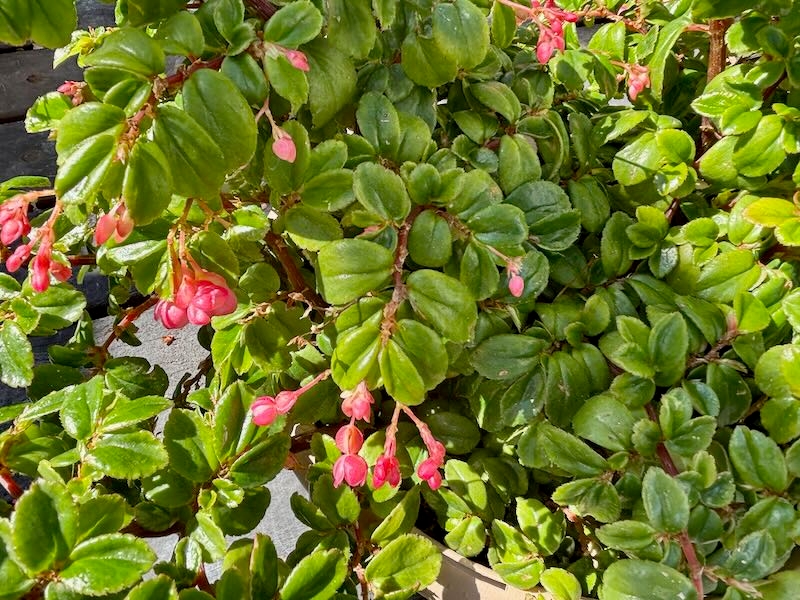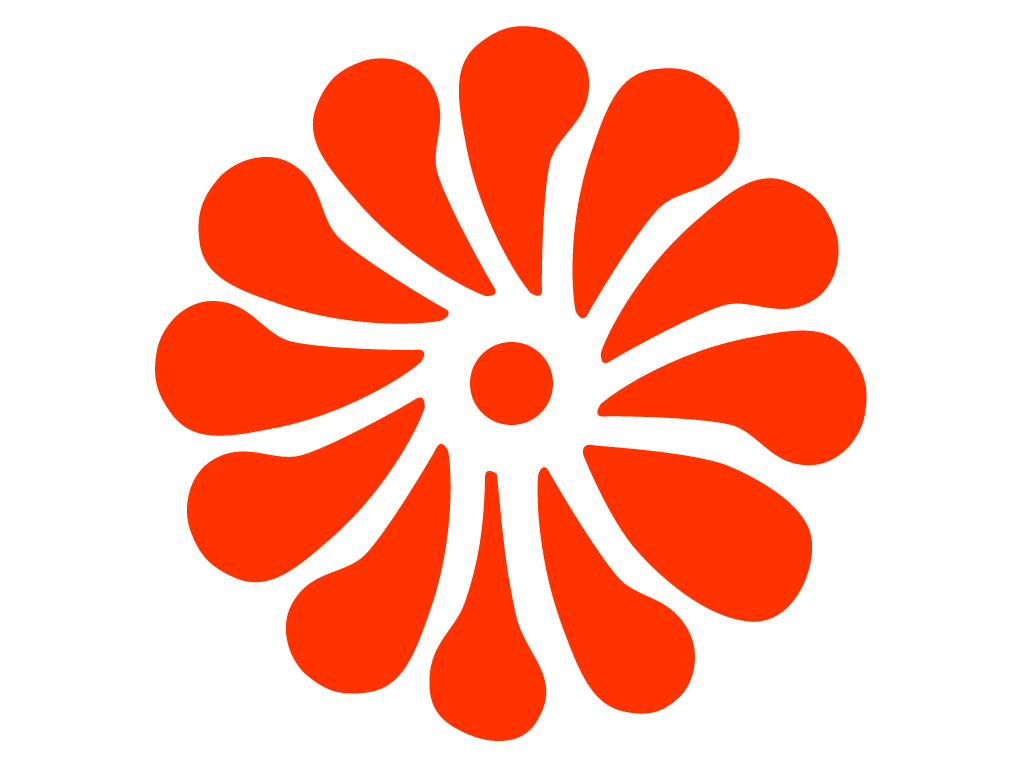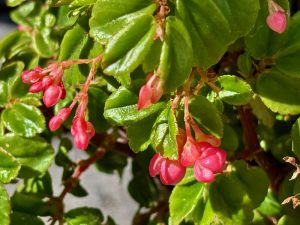Lanterns On Stems: Grow Begonia fuchsioides For Nodding Color In Shade
Begonia fuchsioides brings a drift of tiny lanterns to shady patios and cool gardens. This species, commonly sold as Fuchsia Begonia and sometimes listed as Fuchsia-Like Begonia or Shrub Begonia, dangles clusters of bell-shaped flowers that look like miniature fuchsias. Each spray hangs on fine, reddish stems above glossy, dark green leaves. Belonging to the Begoniaceae family, Begonia thrives in filtered light and steady moisture. Plant it where you want movement, texture, and bloom from late spring well into fall. In frost-free zones you can enjoy flowers almost year-round.
Meet Begonia fuchsioides (Fuchsia Begonia)
Native to the Andean regions of Ecuador, Colombia, and western Venezuela, Begonia fuchsioides evolved in cool, humid forest light. It grows as a compact, multi-stemmed, evergreen subshrub with arching wands. In gardens it typically reaches 60–90 cm tall (2–3 ft) and about 45–60 cm wide (18–24 in). Indoors or in containers, it often stays on the shorter end of that range, especially with regular pinching. The plant keeps a tidy, upright outline that looks at home in mixed shade borders, balcony planters, and bright bathrooms.
Why grow Fuchsia Begonia
You want color in shade without fuss. This begonia answers with long bloom, graceful habit, and resilient foliage. The flowers nod and sway in a light breeze, which gives life to still corners. Pollinators notice. In mild climates, bees and small butterflies visit on warm days. In the tropics and subtropics, hummingbirds stop for nectar. Meanwhile, the leaves hold a polished, evergreen look that reads fresh even in humid summers. Because the plant roots easily from cuttings, you can clone your favorite container to repeat the look along a path.
Size, habit, and texture
Expect thin, reddish stems that branch readily after light pinching. Leaves are small, ovate to elliptic, and glossy; most measure 4–8 cm long (1.5–3 in) with smooth edges and a slight point at the tip. Stems arch under the weight of the flower clusters, so the canopy looks layered. In a pot, the plant becomes a low mound with sprays that lean outward. In the ground, it reads as a small, airy shrub with fine texture that pairs well with larger leaves around it.
Flowering season of Begonia fuchsioides
This species blooms for months. In temperate gardens, expect peak flowering from early summer into fall. In mild, frost-free zones (USDA 10–11), it can produce blossoms on and off all year. Individual flowers are small, yet clusters keep coming. Male and female blooms appear on the same plant. Male flowers show wider tepals and the familiar tuft of yellow stamens; female blooms carry a small winged ovary behind the petals. As blossoms mature, spent clusters drop cleanly and new sprays form at the tips.
Color and form that read from a distance
Flower color ranges from soft pink to clear rose, sometimes shading toward coral red depending on light and temperature. Because blooms hang below the leaves, the show feels natural and layered rather than brash. The display intensifies in bright, indirect light. In deeper shade, flowers still form, but leaf growth takes the lead. Place the plant where morning sun or high, dappled light can reach it and you will see more sprays and richer color.
Where Begonia fuchsioides shines in design
Use Fuchsia Begonia to bridge textures. Set it in front of bold foliage such as Hostas, Clivias, or Elephant Ears to soften edges. Tuck it near the base of Camellias or Hydrangeas to carry bloom into summer. In containers, combine it with trailing Dichondra, Maidenhair Fern, or variegated Plectranthus for contrast. On a covered porch, line three identical pots along a bench and pinch them into mounded, arching domes. The effect looks deliberate and calm.
Climate notes and hardiness
Treat Begonia fuchsioides as a tender perennial. It remains evergreen in USDA Zones 10–11. In Zone 9 it may hold leaves in protected sites but risks cold damage. In cooler regions, grow it as a summer annual or as a houseplant. Night temperatures of 10–21 °C (50–70 °F) keep it happiest. Light frost blackens leaves and can kill stems, so plan for frost protection or overwinter indoors where winters bite.
How to Grow Begonia fuchsioides
Give it the conditions it knows from the forest edge: filtered light, humus-rich soil, and regular moisture with excellent drainage. The following subsections make setup simple.
Light
Place the plant in bright, indirect light. Morning sun for 2–4 hours works well, especially in cooler climates. In hot regions, shield it from midday rays, which can scorch foliage. Indoors, set it near an east or north window, or a bright south window with a gauzy curtain. If leaves pale or internodes stretch, increase light; if tips crisp or leaves bleach, reduce sun exposure.
Soil
Use a loose, airy mix that holds moisture yet drains fast. In beds, blend composted bark or leaf mold into the top 20–25 cm (8–10 in) of soil. Aim for pH 5.8–6.5. In containers, combine a high-quality peat-free potting mix with 30–40% fine pine bark or perlite. Avoid heavy clay or sealed, waterlogged sites. Roots of Begonia resent standing water and poor oxygen.
Watering
Keep the root zone evenly moist, especially during active growth. As a rule, water when the top 2–3 cm (¾–1¼ in) of mix feels dry. Then water thoroughly until liquid exits the drainage holes. Empty saucers so roots never sit in runoff. During heat waves, check daily. In cooler weather, lengthen the interval and water less often. Use rainwater or filtered water if your tap water runs very hard; begonias can show leaf tip burn from salts.
Fertilizing
Feed lightly and often while the plant grows and flowers. Apply a balanced liquid fertilizer at half strength every 3–4 weeks from spring through early autumn. Alternatively, use a slow-release, balanced prill at planting and again midsummer, following label rates. Stop feeding in late fall as growth slows. Excess fertilizer produces big leaves and fewer flowers, so err on the light side.
Temperature and humidity
Aim for daytime temperatures of 18–24 °C (65–75 °F) and nights above 10 °C (50 °F). Short dips below 7 °C (45 °F) can stress the plant. Humidity between 50% and 70% keeps leaves lush and reduces spider mite pressure. Group plants, use a pebble tray, or run a small room humidifier if indoor air is very dry. Avoid misting directly on flowers and leaves; lingering droplets can invite fungal spots.
Containers and repotting
Choose a pot 20–25 cm (8–10 in) wide with generous drainage holes. Terracotta breathes and helps prevent soggy roots, but plastic holds moisture longer in hot, dry rooms. Repot in spring when you see roots circling the base or when watering frequency becomes annoying. Move up only one size at a time. Overpotting slows growth and increases the risk of root rot.
Pruning and training
Pinch young shoots to encourage branching. Use clean fingers or snips to remove the tip just above a leaf node. Repeat every few weeks in spring until the plant fills its shape. Remove spent flower sprays to cue new buds. If stems become lanky, cut them back by one-third in late winter or very early spring. New shoots break from below the cut and rebuild a dense outline.
Mulching in beds
In mild climates, mulch the soil surface with 2–3 cm (¾–1¼ in) of fine bark or leaf mold to hold moisture and steady temperature. Keep mulch a few centimeters away from stems to avoid rot.
Planting and spacing guidance
In beds, plant Begonia fuchsioides 30–45 cm apart (12–18 in). And, in a border, place it near the front where the nodding flowers show. In mixed containers, give it one-third of the pot and surround it with lower fillers and a modest trailer. Indoors, rotate the pot monthly so all sides receive light and stays balanced.
Overwintering strategies
In cold zones, bring containers inside before nights drop to 10 °C (50 °F). Set plants in bright, indirect light and reduce watering. Growth will slow, but the plant can hold leaves and even bloom lightly in a good window. In very low light, stems may stretch. If that happens, cut back in late winter and grow on under brighter conditions for spring.
Propagation of Begonia fuchsioides
Take tip cuttings in late spring or summer. Snip a 7–10 cm (3–4 in) shoot with two or three nodes. Remove the lowest pair of leaves, then insert the cutting into a sterile, moist mix of 1:1 perlite and fine bark or coarse peat substitute. Keep humidity high with a clear dome or a loose plastic bag, and give bright, indirect light. Roots form in about 3–5 weeks at 21–24 °C (70–75 °F). Pot rooted cuttings into a light mix and pinch once to branch.
You can also propagate from semi-ripe stem sections. Leaf cuttings work for many begonias, but this species roots far more reliably from stems. Seed is possible; the seed is dust-fine and needs surface sowing, warmth, and steady humidity. However, plants from seed may show variation, and cuttings give you an exact match to your favorite plant.
Pests & diseases on Begonia fuchsioides
Healthy plants resist most issues, yet regular scouting pays off.
Aphids may cluster on tender tips in spring. Rinse them off with a firm stream of water, then spray with insecticidal soap if they return. Mealybugs hide in leaf axils and along stems; dab visible insects with isopropyl alcohol on a cotton swab and follow with a labeled systemic or repeated soap sprays. Whiteflies can rise in small clouds when you brush the plant; use yellow sticky cards to monitor and a rotation of soap and horticultural oil to suppress. Spider mites show in hot, dry rooms as fine stippling and webbing; raise humidity, increase airflow, and apply a miticide if needed. Thrips can crease or streak petals; remove affected flowers and improve ventilation.
Botrytis gray mold appears in still, humid air on aging flowers and crowded leaves. Improve airflow, remove spent sprays promptly, and avoid overhead wetting. Bacterial leaf spot produces water-soaked patches with yellow halos; discard infected leaves and reduce splash. Root rot (often Pythium or Phytophthora) follows chronic overwatering or tight soil. Repot into an airy mix and water only when the surface dries.
Environmental tolerances and limits
Fuchsia Begonia handles heat if shade and moisture stay steady. It dislikes wind that strips humidity from leaves; in breezy courtyards, place it behind a screen or companion shrub. It tolerates short dry spells once established, but regular, measured water gives better flower production. It does not tolerate frost. Salt build-up from hard water or heavy fertilizer will brown leaf tips; flush the pot thoroughly with plain water every few weeks to leach excess salts.
Companion planting and placement ideas
Pair Begonia fuchsioides with Bronze Heucheras to echo its red stems. Add chartreuse Coleus for a bright foil in shade. Underplant with Maidenhair Fern to repeat the plant’s delicate texture. Along a north-facing path, stagger it with Hosta ‘Halcyon’ and Japanese Forest Grass to mix leaf sizes. In a covered patio planter, set Fuchsia Begonia with Creeping Jenny and white New Guinea Impatiens for continuous bloom and clean contrast.
Safety and handling
Many begonias, including this species, contain soluble calcium oxalates. They can irritate the mouth if chewed and can upset pets’ stomachs. Keep the plant away from curious pets and small children. When you prune, wear gloves if your skin reacts to plant sap. Wash hands after handling and before rubbing your eyes.
Troubleshooting common issues
If leaves yellow from the base upward, check the soil. Water may be sitting in the root zone. Loosen the mix, increase drainage, and allow the top layer to dry between waterings. If stems stretch and flowers thin, move the plant into brighter, filtered light. However, if leaf tips brown, test your water hardness or reduce fertilizer strength and flush the pot. If buds drop, swings in moisture or temperature are likely the culprits. Stabilize the routine and the plant will reset.
Quick measurements and planning reference
Mature size: 60–90 cm tall (2–3 ft), 45–60 cm wide (18–24 in). Ideal indoor humidity: 50–70%. Preferred temperature: 18–24 °C (65–75 °F). Container watering baseline: when the top 2–3 cm (¾–1¼ in) dries. Fertilizer baseline: half-strength balanced liquid every 3–4 weeks in active growth. Outdoor spacing: 30–45 cm (12–18 in). Bloom season outdoors: late spring to frost; nearly year-round in USDA 10–11.
Final notes for success
Plant Begonia fuchsioides in filtered light. Use a loose, humus-rich mix. Water when the top of the soil dries, then let excess drain. Feed lightly through the warm months. Pinch tips to shape, and keep old flower sprays cleared to cue new ones. Protect from frost and harsh midday sun. With these simple steps, Fuchsia Begonia will arch and sway with pendant blooms for months, bringing soft color and fine texture to every shaded corner you cultivate.



